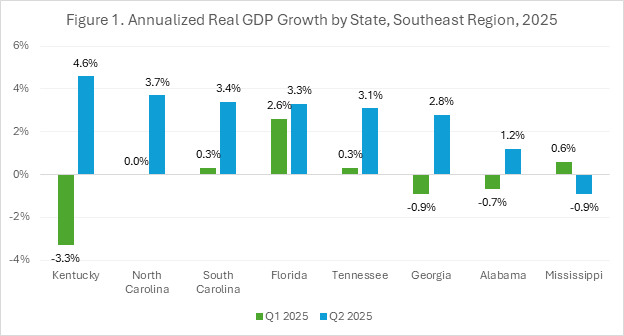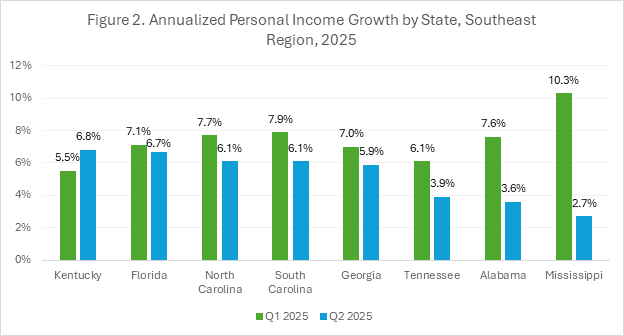Quarter Two, 2025: GDP and Personal Income Grow
By Lainey Stalnaker, Data Analytics Writer
Introduction
Two essential indicators of economic health are gross domestic product (GDP) and personal income. GDP is the market value of all final goods and services produced within a given period of time. It is calculated by adding personal consumption and investments, government spending and investments, and net exports. The greater the GDP of a country, state, or county, the larger its economy.
Personal income is income from all sources, including the typical earnings from wages and salaries, plus employer contributions to employee pension and insurance funds. It also includes income from interest, dividends, and rent (i.e. income from property or assets), and transfers from the government, such as social security or financial aid payments. Contributions to government social insurance programs are excluded.
GDP and personal income data are collected by the Bureau of Economic Analysis and published quarterly at the national and state level [1].
GDP
In quarter two of 2025, South Carolina’s real GDP (which accounts for inflation) grew at an annualized rate of 3.4 percent. This was a strong improvement from quarter one, during which annualized real GDP growth was just 0.3 percent. South Carolina also outpaced neighbors Florida (3.3%), Tennessee (3.1%), Georgia (2.8%), Alabama (1.2%), and Mississippi (-0.9%) during quarter two, as shown in Figure 1.

Note: States are ordered in the table from most to least growth for Q2 2025.
The largest contributor to GDP growth in South Carolina was the manufacturing sector, which accounted for 1.78 of 3.4 percentage points. Finance and insurance contributed 0.56 points, and real estate and rental and leasing contributed 0.53 points. The majority of sectors recorded growth in quarter two, another improvement from the previous quarter.
The largest sector by GDP (in current dollars) was real estate and rental and leasing, which brought in $60 billion to the state in quarter two, followed by manufacturing at $48 billion and retail trade at $30 billion.
Personal Income
Personal income grew at an annualized rate of 6.1 percent in South Carolina from quarter one to quarter two, exceeding the U.S. growth rate of 5.5 percent. South Carolina was on pace with North Carolina, where personal income also grew at a rate of 6.1 percent, and exceeded neighbors Georgia (5.9%), Tennessee (3.9%), Alabama (3.6%), and Mississippi (2.7%). Figure 2 shows personal income growth in quarters one and two of 2025 in the Southeast region [2]. All three components of personal income—earnings, transfer receipts, and property income—increased in South Carolina in quarter two.

Note: States are ordered in the table from most to least growth for Q2 2025.
Conclusion
Both GDP and personal income grew in South Carolina from quarter one to quarter two. Personal income growth was not as high as in quarter one but was still on par with other states in the region. GDP growth was favorable, increasing 3.1 points from the previous quarter. LMI will continue tracking these indicators closely in order to gauge the health of South Carolina’s economy.
2 The Southeast region is defined by the U.S. Department of Labor and includes Alabama, Georgia, Florida, Kentucky, Mississippi, North Carolina, South Carolina, and Tennessee.
